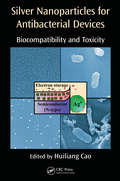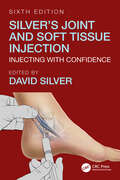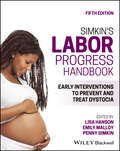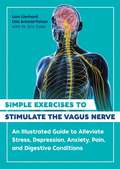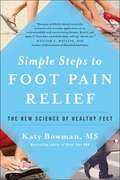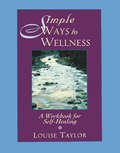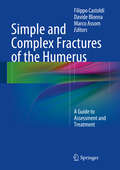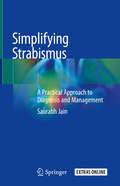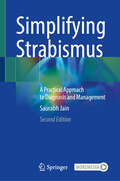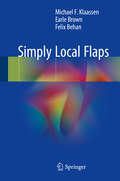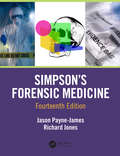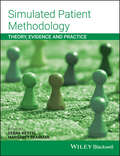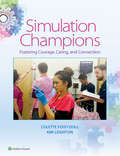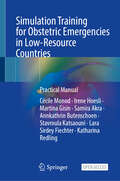- Table View
- List View
Silver Nanoparticles for Antibacterial Devices: Biocompatibility and Toxicity
by Huiliang CaoSince the potential toxicity of silver nanoparticles (Ag NPs) has raised serious concerns in the biomaterials and biomedical engineering community, Silver Nanoparticles for Antibacterial Devices: Biocompatibility and Toxicity brings together the synthesis, the physicochemical properties and the biological actions of Ag NPs, as well as the clinical demands for fabricating antibacterial medical devices, discussing how to suppress the side effects of nanomaterials and how to impart to them the selective toxicity. This book presents the two primary paradigms that have emerged in probing the antibacterial applications of Ag NPs, i.e. the active attacking releasing way and the conservative defending approach by taking advantage of various short-range actions; it shows readers how the ways in which Ag NPs have behaved can be engineered purposively. With contributions from leading international experts and extensive references listed in each chapter, this volume provides the general principles on controlling the physicochemical behaviors of nanomaterials and managing their toxicity risks.
Silver's Joint and Soft Tissue Injection: Injecting with Confidence, Sixth Edition
by David SilverThis popular and practical book is a comprehensive guide to diagnosing joint conditions and the benefits, and potential pitfalls, of steroid injections, an important tool in managing these problems used by an increasing range of practitioners. It considers all the practical aspects of injection as well as providing general information, discussing medico-legal issues and highlighting clinical errors to avoid. This sixth edition has been completely revised and expanded. Key features include: two new chapters on the evidence base and inflammatory arthropathy updated physiotherapy assessment and treatment options now incorporated within the chapters on joint injections full-colour photographs and additional explanatory illustrations The book describes, step-by-step, the required skills for each procedure, providing every practitioner with the knowledge needed to inject with confidence.
SimChart for the Medical Office: Learning the Medical Office Workflow
by ElsevierSimChart For The Medical Office: Learning The Medical Office Workflow - 2020 Edition
SimWars Simulation Case Book: Emergency Medicine
by Lisa Jacobson Yasuharu Okuda Md Yasuharu Okuda Steven A. GodwinThe SimWars Simulation Case Book: Emergency Medicine enables novice simulation operators to quickly and effectively run simulation cases, which have been established at national SimWars events, for their respective programs and departments. Developed by leading emergency medicine simulation experts, this definitive collection of 46 cases includes topics intended to supplement UME and GME training, meet ACGME core competency requirements, and challenge the expert emergency physician in critical decision making, procedural skills, ethical issues, teamwork and communication skills. The use of simulation to gain and maintain skills in healthcare has become critical to the delivery of the curricula in medical schools, nursing schools, residency programs, and hospital-based practice. Specialty boards, such as the American Board of Anesthesiology, now require simulation training as part of the Maintenance of Certification. Studies have shown that one of the main barriers to implementing simulation is the lack of trained simulation instructors and instructor time.
Simkin's Labor Progress Handbook: Early Interventions to Prevent and Treat Dystocia
by Penny Simkin Lisa Hanson Emily MalloySIMKIN’S LABOR PROGRESS HANDBOOK Get ready to enhance your expertise in the world of childbirth with Simkin’s Labor Progress Handbook — a trusted resource tailored for childbirth medical practitioners This invaluable guide unravels the complexities of labor, equipping you with practical strategies to overcome challenges encountered along the way. Inside this comprehensive book, you’ll discover a wealth of low-technology, evidence-based interventions designed to prevent and manage difficult or prolonged labors. Grounded in research and practical experience, these approaches are tailored by doulas and clinicians to provide optimal care and achieve successful outcomes. The fifth edition of this prestigious text includes information on: Labor dystocia causes and early interventions and strategies promoting normal labor and birth Application of fetal heart rate monitoring (intermittent auscultation, continuous electronic fetal monitoring, and wireless telemetry) while promoting movement and labor progress The role of oxytocin and labor progress, and ethical considerations in oxytocin administration Prolonged prelabor and latent first through fourth stage labor, addressing factors associated with dystocia Positions, comfort measures and respectful care With meticulous referencing and clear, practical instructions throughout, Simkin’s Labor Progress Handbook continues to be a timely and accessible guide for novices and experts alike, including doulas, nurses, midwives, physicians, and students.
Simple Exercises to Stimulate the Vagus Nerve: An Illustrated Guide to Alleviate Stress, Depression, Anxiety, Pain, and Digestive Conditions
by Lars Lienhard Ulla Schmid-FetzerControl your stress response through vagus nerve stimulation• Presents more than 100 effective exercises to naturally stimulate the vagus nerve in order to help manage anxiety, depression, sleep, and digestive disorders• Explores the function of the vagus nerve and the organs and systems it&’s connected to throughout the body• Explains how these simple exercises work by improving sensory-information processing, which provides a solid foundation for physical resilience and self-healingIn a world where our lives and daily rhythms are becoming increasingly demanding, being able to implement effective techniques to regulate our stress levels is essential to maintaining a healthy mind and body. The most significant component of the parasympathetic nervous system, which regulates our ability to &“rest and digest,&” the vagus nerve is an information superhighway transmitting information between the brain and the heart, the gut, the immune system, and many organs. By stimulating the vagus nerve, you can work with your parasympathetic nervous system to reduce stress and anxiety, regulate digestion and appetite, moderate heart rate and blood pressure, and balance systems throughout the body. Backed up by the latest scientific research, this book will guide you through more than 100 effective exercises to naturally and gently stimulate your vagus nerve and in turn help manage anxiety, depression, inflammation, sleep, and digestive disorders. The simple techniques include a variety of balance, hearing, sight, breathing, and touch exercises. By improving the quality of stimulation the vagus nerve receives, these neuroeffective exercises enable the brain-gut and brain-heart axes to function more predictably and effectively, providing a solid foundation for mental health, physical resilience, and self-healing.With this comprehensive and accessible guide to natural vagus nerve stimulation, anyone can apply these powerful self-help techniques and experience a more balanced and resilient mind and body.
Simple Medicine: No More Google Searches
by Rob Barkett Jr.Simple Medicine chronicles the change in primary care medicine over the past 50 years. Despite all the new medical technology, studies, medications, specialization, and computers, medical care is fractured. The physician-to-physician relationships have decayed. The federal government and insurance companies are dictating what they think is appropriate medical care. Too many patients are over medicated and not receiving the standard of care that is warranted in 2021. In Simple Medicine, the most common medical conditions, complaints, screening, medications, and medical testing are described in layman terms and very easy to understand, helping patients take control of their own health care and challenge their doctor to do the right thing.
Simple Steps to Foot Pain Relief: The New Science of Healthy Feet
by Katy BowmanDon't just treat your foot pain—strengthen your feet to prevent it. Back with an expanded edition of her popular book Every Woman's Guide to Foot Pain Relief, biomechanist Katy Bowman has created a new version for both men and women in all walks of life. With updated material and new visuals that illustrate exactly how to strengthen and mobilize your feet, Simple Steps to Foot Pain Relief will show you how to change the way you move your body to prevent pain, heal your feet, and halt damage to the rest of your body. Bowman's simple, accessible, innovative program will help you naturally address lower-leg and foot issues such as: - Hammertoes - Bunions - Plantar fasciitis - Poor posture and alignment Bowman walks you gently through exercises to strengthen your feet, what shoes you should (and should not) be wearing, and how these choices affect your overall foot—and whole-body!—health. Simple Steps to Foot Pain Relief will teach you how healthy feet work optimally and help you put your best foot forward on the path toward moving with greater ease.
Simple Treatments for Complex Problems: A Flexible Cognitive Behavior Analysis System Approach To Psychotherapy
by Thomas E. Joiner Kimberly A. Driscoll Kelly C. Cukrowicz Maureen Lyons Reardon Thomas E. Joiner Jr.The Cognitive Behavioral Analysis System of Psychotherapy (CBASP) is a set of techniques that has proven to be efficacious in the treatment of chronic depression. This book describes ways in which it can be extended in the treatment of patients with a wide variety of psychological disorders and difficulties, in a wide variety of settings. Vivid case illustrations and session transcripts illuminate the authors' presentation of appropriate modifications and implementations of the basic approach for personality and anxiety disorders, behavior problems in children, couples distress, and anger. The approach is flexible, efficient, and simple to train. One chapter focuses on methods for helping parents to help their own children more effectively. CBASP has been shown to work both for patients with severe psychological symptoms and for those with more common everyday problems; both for those who are psychologically sophisticated and for those who are not. Simple Treatments for Complex Problems offers powerful new tools for the clinical armamentarium of mental health professionals who do psychotherapy, and the conceptual armamentarium of those who train them and study treatment effectiveness.
Simple Ways to Wellness
by Louise TaylorThis workbook teaches how to use affirmation, visualization, acupressure, and color therapy - easy non-invasive methods of self-healing for everyday complaints. It is organized alphabetically by ailment, from allergies and elbow problems to sciatica and wrist pain, with descriptions and illustrations of the specific acupressure points, affirmations, visualization themes, and effective color therapies for each.Simple Ways to Wellness offers you the tools to take responsibility for your own well-being and will become a reference book to turn to again and again.
Simple and Complex Fractures of the Humerus
by Filippo Castoldi Davide Blonna Marco AssomThe treatment of humeral fractures is a complex issue and the source of considerable controversy. In the case of fractures of the proximal humerus, early range of motion is the main aim of treatment. If a fracture modifies the anatomy or function of the glenohumeral and scapulothoracic joints, the surgeon must adhere meticulously to treatment principles in order to ensure a satisfactory outcome. Humeral shaft fractures are frequent, accounting for 1% to 3% of all fractures in adults; while excellent functional results have been reported with nonoperative management, open reduction and internal fixation is preferred in specific clinical settings. In contrast, intra-articular fractures of the distal humerus are frequently complex and full functional recovery is difficult to achieve. This volume clearly explains the concepts that are central to an understanding of humeral fractures from the proximal to the distal tip. Indications for different forms of treatment, including nonsurgical, are presented in detail, and all of the commonly used fixation techniques are described with the help of high-quality illustrations. Further important aspects such as complications, rehabilitation, and treatment of sequelae are also fully considered. This book will be an invaluable and comprehensive aid for all surgeons who treat humeral fractures.
Simple: The Inner Game of Ophthalmic Practice Success
by John B. PintoNow in its Second Edition, Simple: The Inner Game of Ophthalmic Practice Success makes even the most complex issues in ophthalmic practice management just that- simple. This handy guide covers everything from the basics of business planning to esoteric and complex topics unique to ophthalmology.Author John B. Pinto, a world-renowned expert on the business of ophthalmic practice, has brought his decades of expertise to bear in this high-yield handbook. Throughout his career he has seen that the most successful practices large or small have learned to see the big picture and keep things simple. This book helps practice owners, managers, and administrators achieve that goal.Simple cuts through the details and the minutia of running a practice to refocus on the big picture and the key, high-impact factors influencing ophthalmic practice success. Each chapter addresses a new topic, pointing out stumbling blocks and key areas to focus on so practice owners and managers can stick to their strategic goals. With a foreword by Dr. Richard Lindstrom and hundreds of management pearls throughout, Simple: The Inner Game of Ophthalmic Practice Success, Second Edition takes the guesswork out of running an ophthalmic practice. From data analytics to the ins and outs of administration, John B. Pinto makes practice management simple.
Simplified Diet Manual
by Andrea K. MaherHospitals and long-term care facilities in every state and many foreign countries use the Simplified Diet Manual to assist them in planning nutritious, appealing, and cost-effective meals that are modified to meet the dietary requirements of individuals with special health needs.<P><P> While reflecting the dynamic nature of the field of nutrition, the Eleventh Edition of the Simplified Diet Manual retains its basic purpose: providing consistency among diet terminology, in a simplified manner, for the prescription and interpretation of diets or nutrition plans. The concise, user-friendly format of this resource helps dietitians and foodservice managers succeed in their vital role in maintaining nutritional health and well-being of clients in long-term care facilities, hospitals, and outpatient servicecenters.Revisions and additions to the Eleventh Edition of the Simplified Diet Manual include:Update of the Guidelines for Diet Planning based on Dietary Guidelines for Americans 2010<P>Inclusion of updated Study Guide Questions at the end of each chapter for training foodservice employees in health care facilities that are served by a registered dietitian or dietary consultant.Inclusion of online patient education handouts that coordinate with selected therapeutic diets in the manualRevision of FOOD FOR THE DAY tables using wider variety of culturally diverse foodsAddition of the Mechanical Soft and Pureed DietsAddition of the Small Portion DietRevision of the Fat Restricted DietsAddition of the DASH DietRevision of the Diets for Kidney and Liver Disease to include potassium and phosphorus food lists and a section on Guidelines for Liver DiseaseAddition of the Kosher DietInclusion of Choose Your Foods, Exchange Lists for Diabetes (2008, American Dietetic Association, American Diabetes Association)
Simplified Vestibular Rehabilitation Therapy
by Byung In HanThis book describes a streamlined version of vestibular rehabilitation therapy (VRT), an exercise-based approach that is of proven value in the treatment of vertigo and dizziness. This simplified form of VRT is intended for use in primary healthcare facilities. As Dr. Han had practiced martial art and ballet, he could pick out necessary movements from those art forms. The selected movements were used to make the VRT exercises. The opening part describes the indications for and the principles of VRT and provides general information on key exercises. The role of VRT in patients with central dizziness is then discussed. The remainder of the book offers clear, precise guidance on the exercises used in simplified VRT, covering general exercises, gaze stability exercises, postural stability exercises, and habituation exercises. The text is supported by numerous photographs that will help both clinicians and patients to implement the exercises correctly and effectively.
Simplifying Strabismus: A Practical Approach to Diagnosis and Management
by Saurabh JainThis book provides a clear, concise and easy to understand guide to the diagnosis and management of strabismus. Throughout the text, a practical approach to examining, diagnosing and treating patients with strabismus is utilised, supported with case studies in the form of patient photographs and ocular motility videos. Flowcharts and tables are included, together with evidence based management plans and suggestions for further reading. Simplifying Strabismus: A Practical Approach to Diagnosis and Management is aimed at optometrists, junior and senior ophthalmologists, as well as any medical professional wishing to improve their knowledge of strabismus.
Simplifying Strabismus: A Practical Approach to Diagnosis and Management
by Saurabh JainThis book provides a clear, concise and easy to understand guide to the diagnosis and management of strabismus. Throughout the text, a practical approach to examining, diagnosing and treating patients with strabismus is utilised, supported with case studies in the form of patient photographs and ocular motility videos. Flowcharts and tables are included, together with evidence based management plans and suggestions for further reading. Simplifying Strabismus: A Practical Approach to Diagnosis and Management, 2nd Edition has been fully revised and features a new chapter on strabismus surgery. This book will be an essential resource for optometrists, junior and senior ophthalmologists, as well as any medical professional wishing to improve their knowledge of strabismus.
Simply Local Flaps
by Michael F. Klaassen Earle Brown Felix BehanThis book provides a useful framework for categorizing local flaps on the basis of their composition, blood supply, geometry and means of transfer. The initial chapters are dedicated to the fundamentals – the basic procedures, how to get started, and technical tips – as well as advice on wound care and scar management. These practical pointers are essential for students of plastic surgery, while also offering helpful refreshers for experienced practitioners. The subsequent chapters describe the types of flaps that are traditionally taught and the 10 most common flaps. There is also a practical guide to W-plasty, Z-plasty and their various modifications, which can be applied to both scar revision and the closure of the donor sites. The book also discusses the Keystone Perforator Island Flap (KPIF) and its application to various body sites, offering elegant solutions to some very tricky situations. In turn, the book’s final chapters are focused on assessment, decision-making and lessons learned – essentially, how to decide if a skin graft is the better choice, matters relating to aesthetics, and dealing with complications.Rather than demonstrate exactly how to execute flaps, the book’s primary goal is to inspire students and trainees to think about the reconstructive problem, consider all patient-related and anatomical factors, and accurately recognize what can feasibly be achieved.
Simply The Brain (DK Simply)
by DKThe human brain is a most remarkable organ, but how well do we really understand the way it works?What is a brain and what is the mind? Do you only use 10% of your brain? Why do some people hear colour? If you find yourself seeking the answers to these questions and many more, then Simply The Brain may be the book for you!Simply The Brain explores everything that goes on in the brain when you think, feel, and perceive the world around you. If you&’re seeking a guide that breaks down the inner workings of the mind and the brain, in a way that is easy to understand and jargon-free, then this essential guide is packed with everything you need to understand the basics quickly and easily. Covering more than 90 key ideas from neurons and nerves to forming memories and brain implants, each pared-back entry explains the concept more clearly than ever before.Dive straight in to discover: Simple, easy-to-understand graphics help to explain more than 90 key conceptsCovers all aspects the brain to give a brief overview of this complex subjectConcise explanations quickly convey the most important informationCombining bold, elegant graphics with easy-to-understand text, Simply The Brain is the perfect introduction to the subject for those who are short of time but hungry for knowledge, so if you&’re interested in neuroscience or curious about how the mind works - then this is the book for you!
Simpson's Forensic Medicine, 14th Edition
by Jason Payne-James and Richard JonesPrestigious and authoritative, this fully updated fourteenth edition of Simpson's Forensic Medicine remains a classic; one of the world's leading introductory texts in the field of forensic medicine. It presents all that the generalist or student needs to know about the interface between medicine and the law.
Simulated Patient Methodology
by Debra Nestel Margaret BearmanSimulated Patient Methodology is a timely book, aimed at health professional educators and Simulated Patient (SP) practitioners. It connects theory and evidence with practice to ensure maximum benefit for those involved in SP programmes, in order to inform practice and promote innovation. The book provides a unique, contemporary, global overview of SP practice, for all health sciences educators.Simulated Patient Methodology:* Provides a cross-disciplinary overview of the field* Considers practical issues such as recruiting and training simulated patients, and the financial planning of SP programmes* Features case studies, illustrating theory in practice, drawn from across health professions and countries, to ensure relevance to localised contextsWritten by world leaders in the field, this invaluable resource summarises the theoretical and practical basis of all human-based simulation methodologies.
Simulating the Brain: A Four-Step Method Using Ordinary Differential Equations and Python (Brain Informatics and Health)
by Daniele Caligiore Samuele CarliThis book presents a new methodology to develop system-level brain models using ordinary differential equations (ODE), which are to be solved and analyzed through simple Python scripts. Computer simulations of this kind of models allow the study of healthy and damaged brain functions, the discovery of new neural pathways that may be crucial for the emergence of pathologies, and to simulate the effects of possible new therapies acting on brain actors which are difficult to investigate in traditional research.The methodology consists of four steps: (i) design the model architecture which represents the interactions between different brain areas; (ii) write the ODE system which are implied by the model; (iii) build a Python script that correctly solves the equations; (iv) optimize the free model parameters using genetic algorithms or other techniques to obtain one or more model instances that reproduce the target investigated behavior.This book is for all people who want to learn how to use Python and ODE to simulate brain functions regardless of their backgrounds. While rigorous mathematical proofs of many aspects of the arguments discussed are out of the scope of this work and are therefore omitted, the most important concepts necessary for the critical judgment and self-assessment of the practitioner’s work are exposed in a simplified, readily applicable form, with extensive references for the adventurous reader to explore. The book is a self-consistent textbook containing all pieces necessary to learn from scratch: from the essential mathematical and computing tools to the knowledge necessary to design, simulate, visualize, and interpret brain models. These skills are acquired through several hands-on examples explained step-by-step. One important and distinctive aspect of the book is that, beside the theory, it provides the necessary contexts and practical examples which are key to the correct application of the proposed methodology.
Simulation : bonnes pratiques pour la formation en soins infirmiers
by Vicki Moran Rita Wunderlich Cynthia RubbelkeCe livre présente les normes fondées sur les preuves pour l’enseignement de la simulation en soins infirmiers. Le principe fondamental de l'excellence et de la pertinence de la simulation en soins infirmiers est détaillé tout au long de l'ouvrage. Il aborde également les éléments nécessaires à une simulation de qualité, de son développement à sa mise en œuvre. Ces domaines (non exhaustifs) incluent le contexte théorique, l'accréditation et normes d'homologation, l'environnement, le développement et la mise en œuvre de différents types de simulations et enfin le débriefing. Ces domaines sont décrits sur la base d’un examen approfondi de la littérature et des pratiques actuelles proposées par l'International Nursing Association for Clinical Simulation and Learning (INACSL), la Society for Simulation in Healthcare (SSH), la National League for Nursing (NLN) et les State Boards of Nursing (USA). Cet ouvrage deviendra rapidement un guide de référence pour de meilleures pratiques de la simulation dans l'enseignement des soins infirmiers.
Simulation Champions: Fostering Courage, Caring, and Connection
by Colette Foisy-Doll Kim LeightonSetting out to design a nursing simulation program or to improve one already in place? Drawing on the personal experiences of experts and pioneers in the field, Simulation Champions: Fostering Courage, Caring, and Connection offers the practical information needed to deal with the real challenges of creating or improving a simulation program, along with detailed information on the change management and leadership skills needed for success. Whether you are building a nursing simulation program from the ground up or are seeking to improve an existing program, you will find the information and tools you need to develop strategies for adoption, maintenance, and evaluation, including coverage of important considerations, such as physical space, budget, curriculum and human resources.
Simulation Training for Obstetric Emergencies: Practical Manual
by Cécile Monod Irene Hoesli Samira Akra Martina Gisin Annkathrin Butenschoen Stavroula Katsaouni Lara Sirdey Fiechter Katharina RedlingThis practical book is a highly valuable resource specifically tailored to low-income countries, with the aim of enhancing maternal and fetal health outcomes by reducing morbidity and mortality rates. Drawing from simulation courses on obstetric emergencies, this book offers a concise and accessible overview of the most crucial obstetric emergencies and their appropriate management. The clear and organized structure enables readers to easily locate specific topics, while additional tables and illustrations complement the written content, enhancing comprehension. This book will benefit obstetricians, midwives, and medical personnel responsible for the care of pregnant women. Its practical approach and comprehensive coverage make it an essential companion for healthcare professionals in low-income countries, equipping them with the knowledge and skills necessary to address obstetric emergencies effectively. Overall, it provides a valuable resource that will undoubtedly contribute to improving the quality of maternal and fetal healthcare in resource-limited settings. This is an open access book.
Simulation Training in Laparoscopy and Robotic Surgery
by Hitendra R.H. Patel Jean V. JosephThe field of minimally invasive surgery (MIS) has now taken centre stage in modern clinical practice. With ever changing technologies in the field of MIS, such as robotics, there is now the need to train the surgeon to the next degree. Training by simulation, whether virtual, hybrid, or real, allows the surgeon to rehearse, learn, improve or maintain their skills in a safe and stress free environment. Simulation Training in Laparoscopy and Robotic Surgery gives a true insight into the latest educational and learning techniques for new technologies in surgery. Written by an international team of experts, this illustrated text provides advice on specialised team training, non technical skills and simulation. Simulation Training in Laparoscopy and Robotic Surgery is an important training aide for surgeons and residents interested in developing skills in this field.
